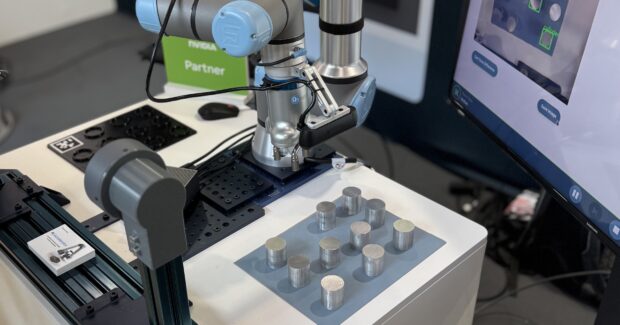AI-powered Tools: Analyze and Adapt in Real Time and Improve Outcomes
AI’s impact on manufacturing is profound. We are just scratching the surface of what will be possible.
Posted: January 15, 2025
Artificial intelligence strengthens the design process, provides real-time insights, enhances vision inspection systems, optimizes energy consumption, and more — driving efficiencies, innovations and opening up new opportunities.
New AI Accelerator Enables a new Wave of Cobot Innovations
Universal Robots’ (UR) (Odense, Denmark) UR AI Accelerator is a ready-to-use hardware and software toolkit created to further enable the development of AI-powered cobot applications.
Designed for commercial and research applications, the UR AI Accelerator provides developers with an extensible platform to build applications, accelerate research and reduce time to market AI products.
The toolkit brings AI acceleration to UR’s next-generation software platform PolyScope X and is powered by NVIDIA Isaac™ accelerated libraries and AI models, running on the NVIDIA Jetson AGX Orin™ system-on-module. Specifically, NVIDIA Isaac Manipulator gives developers the ability to bring accelerated performance and AI technologies to their robotics solutions. The toolkit also includes the newly developed Orbbec Gemini 335Lg 3D camera.
Through in-built demo programs, the AI Accelerator leverages UR’s platform to enable features like pose estimation, tracking, object detection, path planning, image classification, quality inspection, state detection and more. Enabled by PolyScope X, the UR AI Accelerator also gives developers the freedom to choose exactly what toolsets, programming languages and libraries they want to use and the flexibility to create their own programs.
AI-Powered Tool Path Management

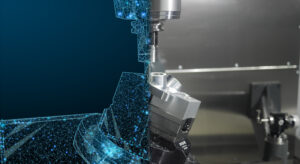
Hexagon’s (North Kingstown, RI) ESPRIT EDGE paired with NCSIMUL simulation software leverage artificial intelligence (AI) and digital twins to revolutionize CNC machining processes. ESPRIT EDGE features digital twin technology, AI, next generation automation tools, and CAM programming to drive all of your CNC machinery. NCSIMUL simulation software helps validate G-code and optimize machining processes in a virtual environment.
By automating tasks like process planning, optimizing tool paths, and synchronizing multi-channel machines, this solution enhances efficiency and reduces cycle times. Additionally, the ability to extend tool life and improve machine performance contributes to overall cost savings and increased productivity.
AI in CAM Software Provides Seamless Access to Knowledge

Sandvik Manufacturing Solutions (Stockholm, Sweden) has added Manufacturing Copilot to CAD/CAM software Cimatron, GibbsCAM and SigmaNEST. The Manufacturing Copilot will enable a shift in the user experience with seamless access to knowledge, which is not broadly accessible today, simplifying the user experience. Each Copilot has been trained on proprietary knowledge, unique to each brand, such as product knowledge base, and prompt optimized during 12 months. The Copilots will be further trained on technical support continuously and eventually connect with each other to bring even more intelligence to the shop floor.
The Manufacturing Copilot is developed in collaboration with Microsoft Azure cloud and AI services. This will provide customers with a simple and more accessible experience with 24/7 intelligent customer assistance. The Copilot offers real-time updates and enables informed choices. This is the first step in the AI roadmap to enhance the customer experience.
The functionality is available in connection to the next versions of the CAD/CAM solutions: Cimatron for die and mold, GibbsCAM for advanced machining and SigmaNEST for sheet metal fabrication. Sandvik plans to integrate the Manufacturing Copilot gradually into more manufacturing software in the portfolio, also within metrology, enabling AI for its 400,000 users globally.
“We are rolling out new capability to help simplify manufacturing by decreasing the learning curve, repetitive tasks and time spent on programming a job,” said Magnus Malmström, Chief Technology Officer at Sandvik Manufacturing Solutions. “It will simplify onboarding as well for advanced users. We understand customers are facing challenges adopting new technology, often due to disconnected platforms, production targets and having higher demands upon a changing workforce.”
By making manufacturing knowledge more accessible through natural language via generative AI, Sandvik wants to support human creativity at every stage of the process, from design to finished product.
www.manufacturingsolutions.sandvik
New Laser Measuring System Adds AI to Plate Rolling
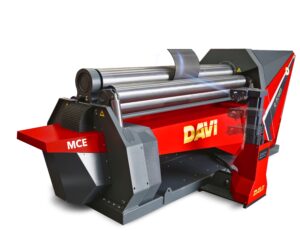
The new iVision Laser Measuring System from Davi Inc. (Dallas, Texas) provides a solution to skilled labor shortage through unmanned operation capability. As experienced plate rolling machine operators retire, they take with them decades of knowledge. Incorporating that existing knowledge base, Davi developed its new iVision laser radius measuring system for its e-POWER fully electric machines that brings artificial intelligence (AI) to the plate rolling process, making it significantly simpler and giving shops the ability to run machines unmanned.
With the combination of AI and a specific algorithm, iVision encompasses reading/measuring and self-correction through the e-POWER fully electric machine’s CNC to automatically adjust in real time. This streamlines the rolling process and ensures the most accurate results in the shortest amount of time possible.
In a typical rolling process, operators will load a plate and start rolling. As the plate is rolled, they manually check its radius with a template, then return to the control, make the adjustment, advance the plate further and repeat the procedure until the desired radius size is achieved. This back-and-forth procedure can happen several times during a single plate rolling sequence. Because iVision eliminates the need for templates, the system not only speeds the process, but it also significantly reduces the need for highly experienced operators to make those manual adjustments.
Unlike other similar systems, iVision uses a “laser blade” as opposed to just a single laser beam point. The laser blade scans a wider rounded area, taking thousands of points along the curved surface of the radius at one time. When systems use only one laser beam point, there is a risk that material surface mill scale and other shop environmental conditions such as light reflections could negatively affect the measurements. The iVision eliminates these risks.
Another advantage is that iVision’s laser head moves up and down in the vertical axis as well as tilts. Such capability ensures that the laser blade is always in the ideal position for measuring the radius regardless of its size. Once a measurement is taken, the system sends the reading point data to the e-POWER’s CNC that then quickly makes the required side roll adjustments in real time.
Robot Simulation Software Includes Augmented Reality

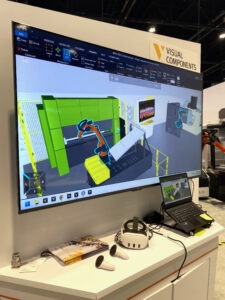
KUKA Robotics’ (Shelby Township, MI) KUKA.Sim is built on technology from KUKA-owned Visual Components, a company that specializes in software solutions for 3D simulation in factory planning.
With its easy-to-use products and open architecture, the Finland-based Visual Components sets standards in the visualization and simulation of complete production processes.
Through digital twins of the automation processes, KUKA.Sim software enables manufacturers to test and validate robotic installations before equipment arrives, minimize the footprint of cells with 3D visualization of safety spaces, then transfer applications with 100% accuracy to an actual robot controller. In addition, KUKA.Sim can program robots offline, analyze cycle times and expand with new functionalities through add-on modules.
KUKA.Sim checks reachability and detects collisions in the virtual space to ensure foolproof implementation of programs and cells, minimizing the time and costs of planning tasks as well as actual production downtime. Through a digital twin that matches the physical process, 3D simulation covers the full planning process from design and verification through PLC code, eliminating bottlenecks with full consistency for advance testing and optimization.
For KUKA, the simulation tool is an important milestone with significant potential for solutions in the company’s simulation ecosystem. Such simulation is one of the key elements for technological innovations such as artificial intelligence, virtual and augmented reality, cloud technology and the Industrial Internet of Things.
2D Vision Sensor Delivers Out-of-the-Box AI Inspections
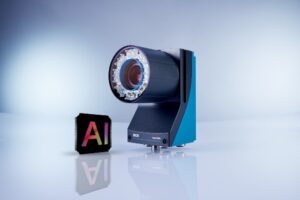
SICK Inc.’s (Minneapolis, MN) Inspector83x 2D vision sensor delivers out-of-the-box solutions for common inline inspection tasks in demanding high-speed production. The no-stress teach-in capability of the SICK Inspector83x can be used by non-specialists to configure powerful, high-precision artificial intelligence (AI) inspections at full production speeds. By showing the camera just a handful of examples, initial inspection results can be up and running in a matter of minutes. Any product design or batch changes can be quickly added in the same way by an operator from the production line.
With its powerful quad-core CPU and high-speed data transfer over industrial networks, the Inspector83x processes AI inspections directly on the device, and at significantly faster speeds than its predecessors. Its highly accurate and fast response, with no need for an external machine control, is expected to be particularly useful in demanding FMCG production applications. Typically, up to 15 inspections per second can be accomplished reliably for machine vision tasks such as defect and anomaly detection or classification.
For complex scenes with many more examples and large datasets, users have the option to access the computational power of the SICK dStudio cloud service to train their own neural network, which can then be exported as a small file to run on the Inspector83x.
New Partnership Regarding Lasers with Artificial Intelligence
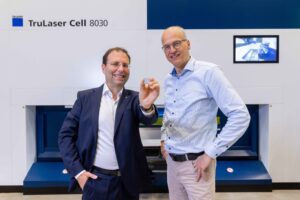
The high-tech company TRUMPF (Farmington, CT) and SiMa.ai (San Jose, CA), the software-centric, embedded edge machine learning system-on-chip company, have signed a partnership to develop lasers with artificial intelligence (AI). The goal is to equip several laser systems of TRUMPF with AI technology in the near future. This includes systems for welding, cutting and marking, as well as powder metal 3D printers.
“AI has high strategic relevance for TRUMPF,” said TRUMPF Laser Technology’s Chief Technology Officer Richard Bannmüller. “Our expertise in laser processes and manufacturing helps us to develop smart software for production purposes. SiMa.ai is the ideal partner for this next big step towards intelligent industrial solutions.”
Both companies bring their respective expertise to the collaboration: TRUMPF, its laser application expertise, and SiMa.ai, its machine learning system on chip (MLSoC) technology.
“In combination with TRUMPF’s advanced AI software, SiMa.ai’s one software-centric platform for all edge AI adjusts to any framework, network, model, sensor, or modality, making it possible to reach the next level of AI-assisted laser technology,” said SiMa.ai Head of Sales and President of Automotive Business Harald Kröger.
Edge ML applications that run completely on SiMa.ai’s machine learning system on chip see a tenfold increase in performance and energy efficiency, bringing higher fidelity intelligence to ML use cases spanning computer vision to generative AI, in minutes. At TRUMPF, approximately 90 employees worldwide are working on AI, primarily in product development.
The joint collaboration intends to accelerate complex material processing. The AI chips will be integrated directly into the laser systems. The AI-optimized sensor technology can monitor the quality of the laser welding process in real time and evaluate more than 3,000 images per second. In electric car production, for example, the real-time quality inspection during laser welding with the help of AI is expected to replace separate and complex testing procedures. Moreover, battery manufacturers will be able to increase the quality of their production in real time and reduce the reject rate.
First AI Add-on for CAM is Available for Siemens’ NX
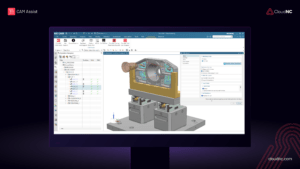
CloudNC’s (London, England) CAM Assist, which uses artificial intelligence (AI) to generate machining strategies for 3 and 3+2 axis CNC machines, is now available for Siemens’ (Chicago, IL) NX CAM software. The new software is available as an AI-enabled add-on for Siemens’ NX software for product engineering and manufacturing, which is used by corporations and machine shops alike. The development means more CNC programmers globally can use CAM Assist, helping them easily program tool paths and machine parts more efficiently than ever before.
CAM Assist uses advanced computer science techniques and AI to generate intuitive machining strategies in minutes or seconds, depending on complexity, which could take CNC machine programmers hours or even days to manually create.
As a result, the amount of time it takes to program a CNC machine to make a component — a bottleneck in many factories — is greatly reduced, compared to the previous manual programming process, as is the time spent to estimate how much a new component will cost to program. That gain enables manufacturers using CAM Assist to raise productivity and shorten lead times, while also estimating for more work, more quickly. Siemens’ NX CAM software is used in industries such as aerospace and defense, automotive and industrial machinery.





